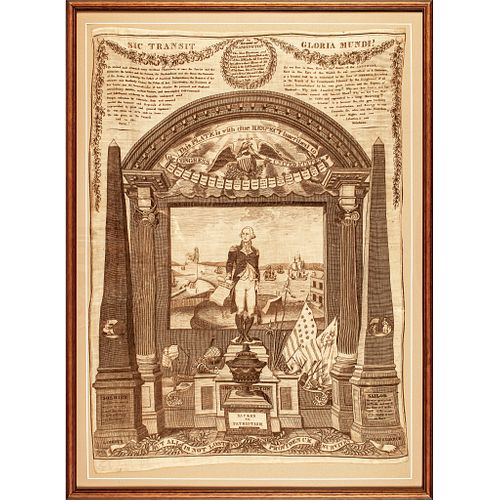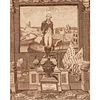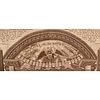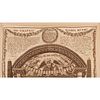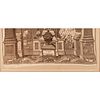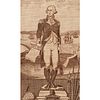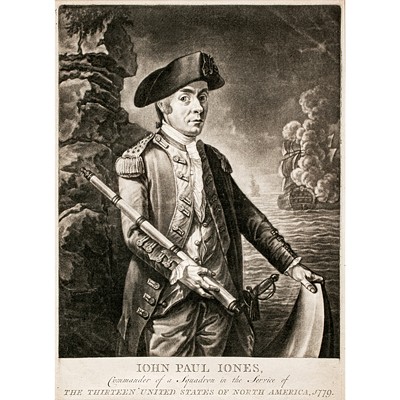1819 George Washington Memorial Printed Textile, THREADS OF HISTORY No. 54 p. 77
Lot 131
Categories
Estimate:
$4,000 - $5,000
Absentee vs Live bid
Two ways to bid:
- Leave a max absentee bid and the platform will bid on your behalf up to your maximum bid during the live auction.
- Bid live during the auction and your bids will be submitted real-time to the auctioneer.
Bid Increments
| Price | Bid Increment |
|---|---|
| $0 | $10 |
| $200 | $20 |
| $300 | $25 |
| $500 | $50 |
| $1,000 | $100 |
| $2,000 | $200 |
| $3,000 | $250 |
| $5,000 | $500 |
| $10,000 | $1,000 |
| $20,000 | $2,000 |
| $30,000 | $2,500 |
| $50,000 | $5,000 |
| $100,000 | $10,000 |
| $200,000 | $20,000 |
| $300,000 | $25,000 |
| $500,000 | $50,000 |
About Auction
By Early American History Auctions
Jan 23, 2021
Set Reminder
2021-01-23 12:00:00
2021-01-23 12:00:00
America/New_York
Bidsquare
Bidsquare : Early American History Auction of Autographs, Americana, Political & Maps
https://www.bidsquare.com/auctions/early-american-history-auctions/early-american-history-auction-of-autographs-americana-political-maps-6311
311 Lots of Rare, Historic Autographs, Americana, Civil War Era, George Washington, Abraham Lincoln, Slavery & Black History, Revolutionary War Era, Colonial America, Federal Period, War of 1812, Colonial Currency, Indian Peace Medals & more... Early American History Auctions auctions@earlyamerican.com
311 Lots of Rare, Historic Autographs, Americana, Civil War Era, George Washington, Abraham Lincoln, Slavery & Black History, Revolutionary War Era, Colonial America, Federal Period, War of 1812, Colonial Currency, Indian Peace Medals & more... Early American History Auctions auctions@earlyamerican.com
- Lot Description
Washington Related
Extremely Rare 1819 George Washington Textile Kerchief Recorded as Number 54 page 71 in "Threads of History"
1819-Dated, George Washington Memorial Textile Kerchief, Portrait of Washington after the famous "Bowling Green" Portrait, Printed in Brown on White Cotton, Listed in "Threads of History" as Number 54 page 71, Framed, Choice Extremely Fine.
This wonderful ornate Printed Textile measures a large 26.25" x 18." It is printed in Brown on White Cotton Linen, archivally displayed on heavy card stock within its frame. Choice extremely fine, having just one 1" long vertical expertly repaired old fabric split at the top of the flagpole left of Washington. This important historic design is listed as No. 54, illustrated on page 71, in Herbert Ridgeway Collins' "Threads of History," published by the Smithsonian, and compares well in quality to their illustration of the New York Historical Society's example. Full margins as issued, all outer border designs are present. It is described as follows: "Portrait of Washington after the 'Bowling Green' (in lower Manhattan, NYC) portrait; marked 'Printed and Published at Glasgow (Scotland) by C.G. {Charles Gray} 1819'.
The original 'Bowling Green' (site of the original Dutch Fort of New Amsterdam, New York) was drawn by Charles Buxton, M.d. (American, 1768-1833), and Gilbert Stuart (American, 1755-1828), engraved by Cornelius Tiebout, and published in 1783 in New York by Charles Smith, who dedicated it to the Congress of the United States.
The view framed in the panel behind George Washington shows the Fort, Bowling Green. General Washington is shown standing on the pedestal from which the Statue of George III had been torn down, from July 9, 1776. Also in the background is the Kennedy House, No. 1 Broadway, where George Washington lived during the early days of the American Revolutionary War and where British General Sir William Howe and other British officers lived during their occupation of New York City. Dedicated both to the memory of Washington and to the Congress. It gives a glowing summary of his career and achievements, and provides excerpts Henry Lee's famous Funeral Eulogy Oration. He tips the hat to the Soldier and Sailor for their contribution and concludes: "But All Is Not Lost For Providence Survives." An example of this engraving is found in the collections of the Smithsonian Institution." We have handled our share of historic George Washington related textiles in the past four decades, yet this is the finest example of this extremely rare large size printed textile that we have offered. Most known examples are housed in museum collections. Overall, marvelous. This example having excellent eye appeal, being the finest example we have offered. Hart 676, Baker 407.
Bowling Green today is a small public park in the Financial District of Lower Manhattan, New York City, at the southern end of Broadway. Located next to the site of the original Dutch Fort of New Amsterdam, it served as a public place before being designated as a park in 1733.
It is the oldest public park in New York City and is surrounded by its original 18th-century fence. It included an actual bowling green and an equestrian statue of King George III prior to the American Revolutionary War.
Bowling Green is surrounded by numerous buildings, including the Alexander Hamilton U.S. Custom House, International Mercantile Marine Company Building, Bowling Green Offices Building, Cunard Building, 26 Broadway, and 2 Broadway. The Charging Bull sculpture is located on its northern end, while Battery Park is located to the southwest. The park is listed on the U.S. National Register of Historic Places under the name Bowling Green Fence and Park.
- Shipping Info
-
Early American provides in-house worldwide shipping. Please contact us directly if you have questions about your specific shipping requirements.
-
- Buyer's Premium



 EUR
EUR CAD
CAD AUD
AUD GBP
GBP MXN
MXN HKD
HKD CNY
CNY MYR
MYR SEK
SEK SGD
SGD CHF
CHF THB
THB